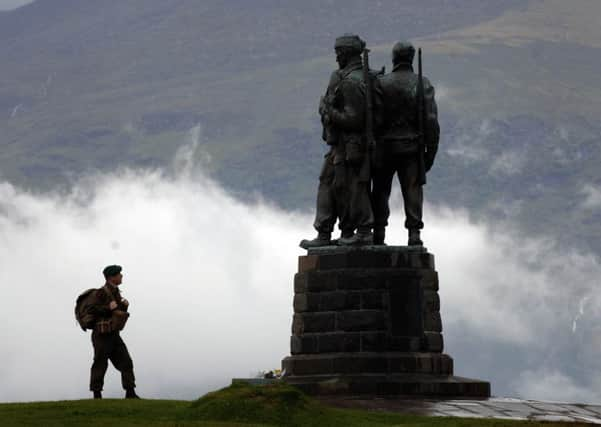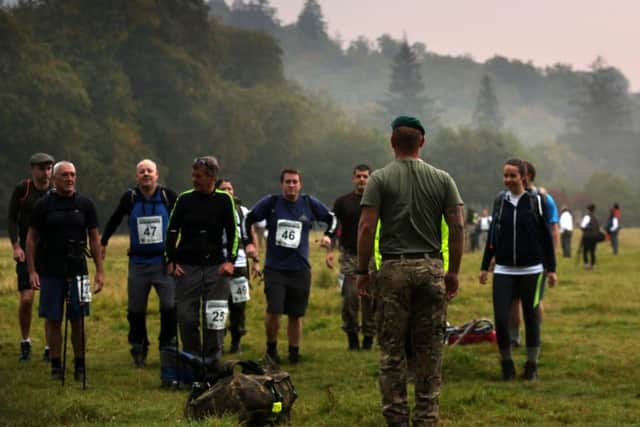Historic WWII Commando assault courses to be recreated in the Highlands


Commando Spirit, the award-winning organisation raising funds to support Commandos and their families, is to rebuild the world’s first Commando assault and endurance courses as part of the first ever Commando Games during 2016 - Scotland’s Year of Innovation, Architecture and Design.
Taking place around the iconic setting of Achnacarry and Spean Bridge in the Scottish Highlands - known from its days as training grounds during WWII as “Commando Country” - the Games will give civilians a chance to experience first-hand the arduous training of the original Commandos.
Advertisement
Hide AdAdvertisement
Hide AdParticipants will be supported all the way by serving and former Commandos,


Authentically replicating the original innovative training, individuals and teams can take on Commando Spirit’s legendary 30-mile trek Survive The Yomp and the nine-mile speed march, known as the Commando March.
The Commando Endurance Course, meanwhile, will include natural obstacles, mud runs, tunnels and crawls.
And the Commando Assault Course will feature rope bridges, obstacles and the infamous death slide.
Sally-Anne Hunter, Commando Spirit Series Founder and Director, said: “We are absolutely delighted to launch our Commando Games and add two awesome new challenge events for 2016.


“Aptly for Scotland’s Year of Innovation, Architecture and Design, our Commando Endurance and Assault Courses are being constructed to accurately replicate the unique historic architectural design and innovative content of the original training courses that service men completed during World War II to become Commandos and earn the right to wear the coveted green beret.
“This is an exciting opportunity for individuals to be the first to complete these authentic courses since they were last undertaken in the 1940s.”
Advertisement
Hide AdAdvertisement
Hide AdShe added: “Commando Spirit is all about showing you have the courage, grit and determination to put yourself through true to life Commando training whilst raising vital funds in the process.
“We passionately believe people have more in them than they appreciate and we encourage people and teams to step up to take part in the unique and iconic Commando Games.”
The Commando Games will take place in Achnacarry over 10 and 11 September.
Participants can take on any or all four of these challenges, while spectators can enjoy Commando inspired entertainment.
The Commando Spirit challenges and Commando Games are part of a year-long programme of events through which participants can test their mettle on training exercises normally only experienced by members of the services - including Royal Marines, solders and airmen - training to be Commandos.
Other challenges include Take The Leap, an eye-watering Commando-style abseil from Glasgow’s Titan Crane on 5 June; and Escape The Dunker, where participants escape from a mock helicopter fuselage in a simulated crash.
Cameron of Lochiel, of Achnacarry Estate, said: “I am absolutely delighted that Commando Spirit is bringing their inspiring new Commando Games to Achnacarry Estate.
Advertisement
Hide AdAdvertisement
Hide Ad“Since 2013, this highly professional team has organised the iconic 30 mile Survive The Yomp at Achnacarry Estate, supporting the growth of our local economy and raising awareness of the uniquely rich Commando heritage of the area.
“I look forward to seeing them build on this success and to welcoming the many brave participants as they prove their mettle at these tough but rewarding Commando Games.”
The award-winning Commando Spirit is headed up by former lawyer and event fundraiser Sally-Anne Hunter, who was named Employer of The Year in 2015 and recently shortlisted for an Inspirational Woman Award.
She was one of only four women to abseil the Shard, Western Europe’s tallest building, and in doing so raised over £500,000 for the Commando Spirit Appeal and was awarded the Best Use of Events Award from the Institute of Fundraising.
A Commando statue was erected on the outskirts of Spean Bridge to recognise the efforts of the Commandos during the war.
Standing 17ft tall, the bronze sculpture is one of Scotland’s best-known monuments.
A nearby Garden of Remembrance is used by many surviving World War II commandos as the final resting place for their ashes.
Advertisement
Hide AdAdvertisement
Hide AdRelatives of soldiers who have died in more recent conflicts, such as Afghanistan, Iraq and the Falklands, have also scattered ashes there in recent years.
The sculpture was created by Wick-born Scott Sutherland, who was schooled at Gray’s School of Art, Edinburgh College of Art and the École des Beaux-Arts in Paris.
After the fall of France, Prime Minister Winston Churchill insisted on maintaining the offensive spirit and called, on June 3, 1940, for the creation of a force “of, say, 1,000 up to no less than 10,000 men” as his ‘butcher and bolt’ raiding unit.
From this urgent plea for offensive operations sprang the commando hit and run hand-picked guerrilla forces, to be dropped by parachute or landed by boat or submarine to strike at the enemy on their own ground.
They were not intended to remain in field operations for more than 36 hours and were to carry all they needed.
The men and the units came to be known as commandos - a name borrowed from the self-sufficient Boer guerrilla units, which had caused the British Army so much grief in South Africa at the turn of the century.
These specialist troops, who were expertly trained in hand-to-hand combat and in various weaponry, fought in the war’s hottest spots.
Advertisement
Hide AdAdvertisement
Hide AdAs the war progressed they operated increasingly in the role of shock troops, sometimes up to brigade strength, and sometimes in conjunction with infantry, and paved the way for victories in north-west Europe, Norway, the Middle East, France, Italy, and Africa. They were not just expert marksmen but battlefield athletes.
The commandos were formed and operated under a veil of secrecy. They had a demoralising effect on German coastal forces while achieving celebrity status among the British public.
Shrouded in myth, they ranked alongside Battle of Britain fighter pilots as popular and iconic heroes.
The Scots made up large numbers of most commando units, including the majority of No 11 unit, which became known as the Scottish Commandos, who were highly feared by their German counterparts.
The legendary No 9 unit was also made up largely of Scottish soldiers and, along with No 11, were dubbed the Black Hackles because of the black feather that adorned their military caps.
The brutal toughness of the training, which included the use of live ammunition rounds and 36-hour exercises, resulted in many fatalities, but it also hardened the soldiers for their mammoth tasks against the Germans ahead.
In 1942, Churchill spoke proudly of his new fighting force. He said: “There comes, from time to time a hand of steel which plucks German sentries from their posts.”
Read more: http://www.scotsman.com/news/uk/final-farewell-for-men-of-steel-1-1399505#ixzz40KZyOnKN